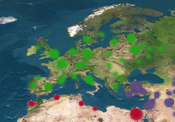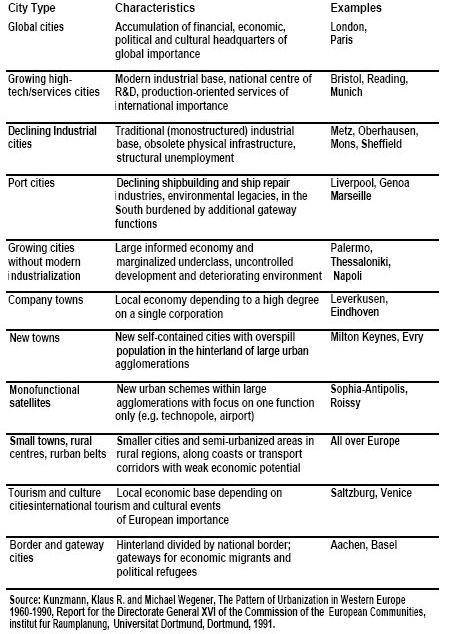2. Urbanisation
Europe

Three-quarters of Europe's inhabitants live in cities. This proportion is, with North America, the highest worldwide. The process has therefore nearly reached the upper boundary of urbanisation rates feasible for a country's economy (Renwick, Rubenstein 1995).
Europe's rapid urbanisation was the beginning of a worldwide process set in motion by the globalising forces of colonialism and the Industrial Revolution. Some 150 years ago starting in England, urban agglomerations grew larger and larger, first in Europe, in the USA and in Japan. In 1950 slightly more than 50% of West Europeans lived in cities, and no major world region was more urbanised than Western Europe. At that time, New York was the largest city in the world and the only one with more than 10 million residents, London (8 million) and Paris (6 million) ranked number 2 and 4, respectively (De Blij, Murphy 2003, Gresh 2007).
Similar to North America, changes in household size, composition and age structure are influencing housing markets and settlement patterns. Europe's annual population growth rates are marginal and have steadily declined over the last decades. These very low population growth rates help explain the common experience of cities with a net loss of inhabitants. The average household size is now below 3 persons, over a quarter of households contain only one person. If the population is not increasing, the number of households is (Pacione 2001).
The 'baby-boom' in the 1940s and 1950s is associated with strong suburbanisation and deconcentration processes. New developments influencing urban structures includes retirement migration as the population ages. Generally, this is seen as population movement away from larger metropolitan centres down the urban hierarchy (Pacione 2001).
Most of the population in Europe is now living in diffuse urban areas with only a few large urban agglomerations like London, Moscow and Paris. A major dichotomy between growing high-tech/service cities and the declining industrial and port cities can be recognised. In the future, a large number of individual, mostly urban-centred regions will compete for jobs, people and capital investment (Gresh 2007, Pacione 2001).
Europe, once the starting point of worldwide urbanisation has departed from the current growth of mega cities. Since the 1970s the number of inhabitants in the large cities in Europe, Russia and large parts of the US remains static. An exception is Istanbul, Turkey's largest city and commercial capital. Its annual urbanisation rates since 1950 have persistently exceeded 3%, making Istanbul Europe's most rapidly growing city (Bronger 2004, Gresh 2007, UN-HABITAT 2001).
Tasks: 1. Summarise the urbanisation process in Europe.
2. Explain the differences between the urbanisation processes in Europe and North America.
Case study: London


